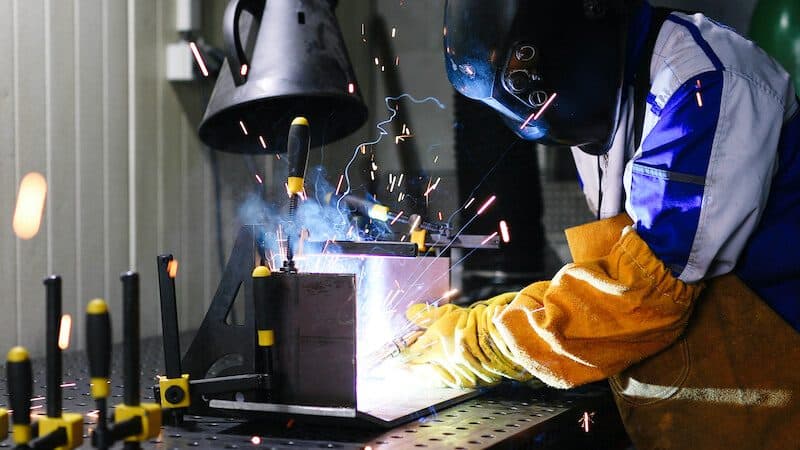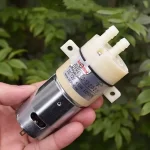What are Welding Sleeves?
Welding sleeves are protective garments designed to cover the arms and shoulders of welders during welding operations. Their primary purpose is to shield the welder’s skin from harmful exposure to intense heat, sparks, and molten metal spatter generated during the welding process.
Welding sleeves are typically made from flame-resistant and heat-resistant materials, such as leather, cotton, or specialized synthetic fabrics like Kevlar or Nomex. These materials are chosen for their ability to withstand high temperatures and provide a barrier against potential burns and injuries.
The sleeves are constructed with multiple layers of protective material, often featuring an outer shell resistant to sparks and molten metal, and an inner lining designed to insulate against heat transfer. Some welding sleeves also incorporate additional features like reinforced elbows, adjustable cuffs, or ventilation panels to enhance comfort and mobility during prolonged welding sessions.
Table of Contents
Importance of Welding Sleeves
Welding sleeves play a crucial role in ensuring the safety and protection of welders during welding operations. These specialized garments are designed to shield the arms and forearms from various hazards associated with welding, such as intense heat, sparks, molten metal splatter, and abrasions.
Safety is the primary concern when it comes to welding sleeves. Welding involves working with high temperatures, open flames, and molten materials, which can pose serious risks of burns, cuts, and other injuries. Welding sleeves act as a protective barrier, preventing direct contact between the welder’s skin and these hazards. They are typically made from fire-resistant and heat-resistant materials that can withstand extreme temperatures without igniting or melting.
In addition to providing thermal protection, welding sleeves also safeguard against sparks and molten metal splatter. During the welding process, small particles of molten metal can be ejected from the weld pool, potentially causing burns or embedding themselves in exposed skin. Welding sleeves are designed to deflect these particles, shielding the welder’s arms and preventing potential injuries.
Furthermore, welding sleeves offer protection against abrasions and cuts. Welders often work in environments where sharp edges, rough surfaces, or debris may be present. Welding sleeves are made from durable materials that can withstand abrasion, reducing the risk of cuts or scrapes on the arms.
Compliance with regulations is another essential aspect of welding sleeves. Many industries and organizations have strict safety regulations and guidelines for personal protective equipment (PPE) in welding operations. Wearing appropriate welding sleeves ensures compliance with these regulations, helping to prevent potential fines or penalties for non-compliance.
Overall, the importance of welding sleeves cannot be overstated. They are a vital component of a welder’s personal protective equipment, providing essential safety and protection against the various hazards encountered during welding operations. By investing in high-quality welding sleeves and ensuring their proper use, welders can minimize the risk of injuries and create a safer working environment.
Types of Welding Sleeves
Welding sleeves are available in various materials, each with its unique properties and advantages. The most common types include:
Leather Welding Sleeves
Leather is a traditional and popular choice for welding sleeves due to its durability and heat resistance. Leather sleeves offer excellent protection against sparks, spatter, and radiant heat. They are thick, sturdy, and can withstand harsh welding environments. However, leather sleeves can be heavy, less breathable, and may require more frequent replacement compared to other materials.
Cotton Welding Sleeves
Cotton welding sleeves are lightweight, breathable, and comfortable to wear. They provide basic protection against minor sparks and heat but are not as durable as leather or flame-resistant materials. Cotton sleeves are often used for lighter welding tasks or in combination with other protective gear. They are relatively inexpensive but may need more frequent replacement due to wear and tear.
Kevlar Welding Sleeves
Kevlar is a synthetic aramid fiber known for its exceptional strength and heat resistance. Kevlar welding sleeves offer superior protection against high temperatures, flames, and molten metal splashes. They are lightweight, durable, and can withstand harsh welding conditions. However, Kevlar sleeves can be more expensive than other materials and may not provide as much insulation against radiant heat.
Aluminized Welding Sleeves
Aluminized welding sleeves are made of a fabric base coated with a reflective aluminum layer. This reflective coating helps deflect radiant heat, making these sleeves highly effective in protecting against burns and heat stress. Aluminized sleeves are often used in high-heat welding applications, such as foundries or aluminum welding. They can be more rigid and less breathable than other materials but offer excellent heat protection.
Combination Welding Sleeves
Some welding sleeves combine multiple materials to leverage the benefits of each. For example, a sleeve may have a leather or Kevlar outer layer for durability and heat resistance, with a cotton or moisture-wicking inner lining for comfort and breathability. These combination sleeves aim to provide comprehensive protection while addressing various welding conditions and user preferences.
When choosing welding sleeves, consider the specific welding process, heat exposure levels, and personal preferences for comfort and mobility. Different materials offer varying levels of protection, durability, and breathability, so it’s essential to select the right type for your welding application and working environment.
Welding Sleeve Standards and Regulations
Welding sleeves are subject to various industry standards and regulations to ensure the safety of welders and compliance with occupational health and safety guidelines. The primary standards and regulations governing welding sleeves include:
ANSI Standards
The American National Standards Institute (ANSI) has established guidelines for protective clothing, including welding sleeves, through the ANSI/ISEA 107-2015 standard. This standard specifies the minimum requirements for high-visibility safety apparel, including the use of specific materials, design features, and performance criteria.
OSHA Regulations
The Occupational Safety and Health Administration (OSHA) has regulations in place that mandate the use of personal protective equipment (PPE), including welding sleeves, in certain work environments. OSHA’s General Industry Standards (29 CFR 1910.132) require employers to provide and ensure the use of appropriate PPE when hazards are present in the workplace.
EN Standards
In Europe, the EN standards, such as EN ISO 11611 and EN ISO 11612, provide guidelines for protective clothing for use in welding and allied processes, as well as for protection against heat and flame. These standards specify requirements for materials, design, and performance testing to ensure adequate protection for welders.
Compliance Requirements
To comply with these standards and regulations, welding sleeves must meet specific criteria related to their materials, construction, and performance. Manufacturers must conduct various tests, such as flame resistance, heat transfer, and durability tests, to ensure their products meet the required standards.
Employers are responsible for providing welding sleeves that comply with the applicable standards and regulations, as well as ensuring that their employees receive proper training on the use and care of these protective garments. Failure to comply with these standards and regulations can result in fines, penalties, and potential legal liabilities.
How to Choose the Right Welding Sleeves
Selecting the appropriate welding sleeves is crucial for ensuring safety, comfort, and productivity during welding operations. Several factors should be considered when choosing welding sleeves to ensure they meet the specific requirements of the welding process, environment, and personal preferences.
Welding Process: Different welding processes generate varying levels of heat, sparks, and molten metal exposure. For instance, stick welding and flux-cored arc welding typically require more robust and heat-resistant sleeves compared to gas metal arc welding (GMAW) or gas tungsten arc welding (GTAW). Evaluate the welding process you’ll be working with and select sleeves designed to withstand the associated hazards.
Environment: The working environment plays a significant role in determining the appropriate welding sleeves. If you’ll be welding outdoors or in areas with high winds, opt for sleeves with secure closures or elastic cuffs to prevent sparks or debris from entering. For confined spaces or overhead welding, consider sleeves with increased mobility and flexibility.
Personal Preference: Comfort and fit are essential factors to consider when choosing welding sleeves. Some welders prefer lightweight and breathable materials, while others prioritize durability and heat resistance. Additionally, sleeve length and fit should be considered based on personal preferences and the welding application. Proper fit ensures unrestricted movement and reduces the risk of snagging or catching on surfaces.
When selecting welding sleeves, it’s also important to consider additional features such as moisture-wicking properties, flame resistance, and cut resistance. Some sleeves may incorporate reinforced areas for added protection against abrasion or heat exposure. Ultimately, the right welding sleeves should provide a balance of protection, comfort, and functionality tailored to your specific welding needs.
Proper Use and Care of Welding Sleeves
Welding sleeves are designed to protect your arms from burns, sparks, and other hazards associated with welding. However, proper use and care are essential to ensure their effectiveness and longevity. Here are some guidelines for the proper use and care of welding sleeves:
Donning and Doffing
Before putting on welding sleeves, ensure your arms are clean and dry. Roll up the sleeves and slide them onto your arms, ensuring they cover the entire area from your wrists to your shoulders. Adjust the sleeves to fit snugly without restricting movement or circulation.
When removing welding sleeves, be cautious of hot surfaces or sparks that may have accumulated on the fabric. Roll the sleeves down your arms, turning them inside out as you remove them to prevent any debris from falling onto your skin or clothing.
Inspection
Regularly inspect your welding sleeves for signs of wear, damage, or contamination. Look for holes, frayed edges, or areas where the fabric has become thin or discolored. If you notice any significant damage, replace the sleeves immediately to maintain adequate protection.
Cleaning
Welding sleeves can accumulate dirt, grease, and other contaminants over time, reducing their effectiveness and potentially posing a fire hazard. Follow the manufacturer’s instructions for cleaning, which may involve washing by hand or machine, depending on the material.
Avoid using harsh chemicals or bleach, as these can degrade the protective properties of the fabric. Ensure the sleeves are completely dry before storing or using them again.
Storage
Store welding sleeves in a cool, dry place, away from direct sunlight and moisture. Avoid folding or creasing the sleeves, as this can weaken the fabric over time. Consider hanging them or storing them flat to prevent permanent creases or folds.
If the sleeves become damp or wet during use, allow them to dry completely before storing them to prevent mildew or other moisture-related damage.
By following these guidelines for proper use and care, you can extend the lifespan of your welding sleeves and ensure they provide optimal protection during welding operations.
Welding Sleeve Manufacturers and Brands
Welding sleeves are available from various manufacturers and brands, each offering unique features and quality standards. Some of the major players in the welding sleeve industry include:
Steiner Industries: Steiner is a well-known brand that offers a wide range of welding sleeves made from high-quality materials like flame-resistant cotton, Kevlar, and leather. Their sleeves are known for their durability, comfort, and excellent protection against sparks, slag, and heat.
Revco Industries: Revco is another reputable brand that specializes in welding safety equipment, including sleeves. Their products are designed to meet or exceed industry standards, ensuring maximum protection for welders. Revco sleeves are available in different materials and styles to suit various welding applications.
Black Stallion: Black Stallion is a premium brand that focuses on providing high-performance welding gear, including sleeves. Their products are known for their innovative designs, superior quality, and advanced protection features. Black Stallion sleeves are often more expensive than other brands but are highly regarded for their durability and effectiveness.
Weldas: Weldas is a budget-friendly brand that offers a range of welding sleeves at relatively lower prices compared to premium brands. While their products may not have the same level of advanced features, they still meet industry standards and provide adequate protection for most welding applications.
Quality and pricing can vary significantly among different brands and models. Premium brands like Steiner, Revco, and Black Stallion generally offer higher-quality sleeves with advanced materials and construction, but they come at a higher cost. Budget-friendly brands like Weldas may be more affordable but may not offer the same level of durability or protection as their premium counterparts.
When choosing welding sleeves, it’s essential to consider factors such as the type of welding you’ll be performing, the level of protection required, and your budget. While premium brands may be more expensive, they can provide better long-term value and increased safety for welders who frequently engage in demanding welding tasks.
Welding Sleeves for Special Applications
Welding sleeves designed for special applications offer enhanced protection against extreme conditions, ensuring the safety and productivity of welders in demanding environments. These specialized sleeves cater to various industries and scenarios where standard welding sleeves may not suffice.
High Heat Resistance
Certain welding processes, such as oxy-fuel welding or working with molten metals, generate intense heat. High heat-resistant welding sleeves are engineered to withstand these extreme temperatures, preventing burns and protecting the welder’s arms from radiant heat. These sleeves often incorporate materials like aramid fibers, which have excellent thermal insulation properties and can withstand temperatures up to 800°C (1472°F) or higher.
Cryogenic Protection
In industries dealing with liquefied gases, such as the petrochemical or aerospace sectors, welders may encounter cryogenic environments with temperatures as low as -196°C (-320°F). Cryogenic welding sleeves are designed to protect against the hazards of extreme cold, preventing frostbite and ensuring the welder’s safety. These sleeves typically feature multi-layered insulation and moisture-wicking properties to keep the welder’s arms dry and comfortable.
Chemical Resistance
Welders working in chemical plants, oil refineries, or other environments with exposure to corrosive substances require specialized welding sleeves that offer chemical resistance. These sleeves are constructed from materials that can withstand prolonged contact with acids, solvents, and other harsh chemicals without degrading or compromising their protective qualities.
Cut and Abrasion Resistance
In industries involving heavy machinery or handling sharp objects, welders may face risks of cuts or abrasions. Cut and abrasion-resistant welding sleeves incorporate materials like high-performance aramid fibers or steel wire reinforcement to provide an additional layer of protection against these hazards, ensuring the welder’s safety during demanding tasks.
Electrical Insulation
Welders working in proximity to live electrical components or high-voltage equipment require specialized welding sleeves with electrical insulation properties. These sleeves are designed to prevent electrical shocks and burns by incorporating insulating materials that effectively block the flow of electrical current, ensuring the welder’s safety in potentially hazardous environments.
By choosing welding sleeves tailored to specific applications and hazards, welders can perform their tasks with confidence, knowing that they are adequately protected against the unique challenges and risks associated with their work environment.
Cost and Lifespan of Welding Sleeves
The cost of welding sleeves can vary significantly depending on the material, brand, and quality. Prices typically range from around $10 for basic cotton sleeves to over $50 for premium leather or flame-resistant options. While cheaper sleeves may seem appealing, investing in high-quality sleeves can pay off in terms of durability and protection.
The lifespan of welding sleeves is influenced by several factors, including the frequency of use, exposure to heat and sparks, and proper care. Generally, cotton sleeves have a shorter lifespan compared to leather or specialized materials. With proper maintenance and storage, high-quality welding sleeves can last for several months or even years.
When it comes to determining when to replace welding sleeves, there are a few key signs to look out for:
- Wear and Tear: If the sleeves show visible signs of wear, such as fraying, holes, or thinning material, it’s time to replace them. Worn-out sleeves may not provide adequate protection against heat, sparks, and burns.
- Discoloration: Excessive discoloration or charring can indicate that the sleeves have been exposed to high temperatures or flames, compromising their protective properties.
- Loss of Flexibility: Over time, welding sleeves can become stiff and inflexible, making them uncomfortable to wear and potentially limiting your range of motion during welding tasks.
- Manufacturer’s Recommendations: Many welding sleeve manufacturers provide guidelines on the expected lifespan of their products. Following these recommendations can help ensure you’re replacing your sleeves at the appropriate intervals.
It’s crucial to replace welding sleeves promptly when they show signs of wear or damage. Continuing to use compromised sleeves can put you at risk of burns, injuries, and potential safety hazards. Investing in high-quality welding sleeves and following proper care and replacement guidelines can help ensure your safety and productivity on the job.
Future Trends in Welding Sleeve Design
The future of welding sleeve design is focused on three key areas: new materials, improved ergonomics, and smart technology integration.
In terms of materials, manufacturers are exploring advanced fibers and fabrics that offer superior heat and flame resistance, while also being lighter and more breathable. Some promising candidates include aramid fibers, carbon nanotubes, and ceramic-infused textiles. These materials could provide better protection and comfort for welders working in extreme environments.
Ergonomics is another major focus, with designers aiming to create sleeves that reduce strain and fatigue during prolonged welding sessions. This could involve ergonomic shaping, adjustable features, and the use of lightweight yet durable materials. The goal is to minimize musculoskeletal injuries and improve overall worker safety and productivity.
Finally, the integration of smart technology is expected to revolutionize welding sleeves. Sensors and monitoring systems could be embedded into the sleeves, allowing real-time tracking of temperature, exposure levels, and other safety metrics. This data could be transmitted wirelessly to a central system, enabling proactive maintenance and replacement schedules. Additionally, augmented reality displays or heads-up displays could be incorporated into the sleeves, providing welders with vital information and instructions without obstructing their line of sight.
Overall, the future of welding sleeve design promises to be more protective, comfortable, and technologically advanced, ensuring the safety and productivity of welders in various industries.



